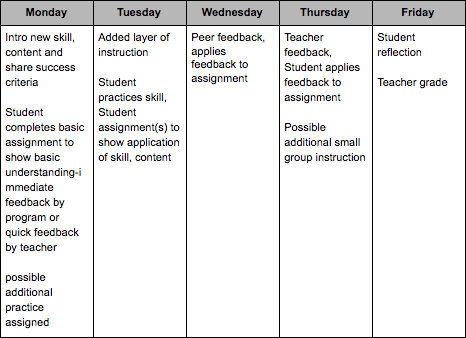Assessment in Asynchronous Learning
It’s week three of distance learning for many of us and thanks to a ticking clock, we are beyond “maintenance” of learning in a virtual space-we are quickly moving into a time where students need to receive instruction and be assessed. As we move into this new chapter of virtual learning, upholding best practices of assessment for learning, rather than assessment of learning feels like a timely topic. We know that descriptive feedback and student reflection are tenants of formative assessment-but how do we do that online? And more importantly how do we manage that process?
Types of assessment
There is a time and place for different depths of assessment. Some assignments are basic-either the student got the concept or they didn’t; while others require more in-depth feedback so that students have an opportunity to grow and learn. For example, a quick online video tutorial and follow up questions aren’t going to showcase great depths of knowledge and therefore the built-in assessment provided by the program or app is probably sufficient. However, an assignment such as an essay or project is going to showcase a variety of content and skills and be more “process-oriented”, therefore they are deserving of more comprehensive feedback from the teacher. Here is what a week might look like that provides these two types of assessment:
How to give Asynchronous feedback
Tech tools and adaptive apps such as Moby Math, Khan Academy and ST Math all provide quick feedback to students on content mastery. And while these are helpful in some contexts I have also watched my own two children guess and click their way through entire tutorials-so lean on these with caution when it comes to depending on them for assessing student knowledge and providing feedback.
A quick and easy way to give descriptive feedback is through voice audio. However, I have found that providing a visual to accompany your feedback is really helpful, in which case using something Flipgrid can be a great tool -it’s super user-friendly for both teachers and students. Leveraging the Google Doc comment feature is also a great way to give specific feedback because you can point to the exact place in the student work that you are referring to in your feedback.
Moving your rubrics over to an online setting is also a great way to continue to uphold best practices of assessment in virtual learning. The process I walk through in this post for Cult of Pedagogy explains how to create robust rubrics, but for the sake of keeping things simple, let’s just think about how we might use a more simplified version of this process. Here is how to use a single-point rubric in virtual learning, with a bonus tool to help!:
- Make a copy of this Single Point Assessment document and save it to your Drive.
- Identify which of the 3 assessment tools provided you want to use and delete the other two
Option 1-elementary
Opton 2- upper elementary, secondary
Option 3-secondary
- Make a copy of your new document for each student and save it as [DOC title: Last name, Assessment WeekXXX] in either their individual student folder in Google Drive to stay organized
- Using the calendar above as a guide, plan for when and how you will use this feedback and reflection tool
- Transfer this tool to the numeric scale in your gradebook for the specific content standard covered
Assessment in asynchronous learning can be time consuming, so descriptive feedback and reflection like that outlined in the tool above won’t happen all the time-but it is a valuable process to help students continue to grow and learn, while also developing their agency.
Additional resources:



